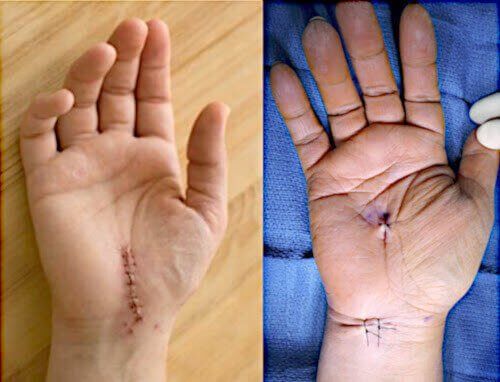Checklist: Carpal Tunnel Surgery Recovery Instructions
From Dr. Z - Carpal tunnel syndrome specialist
Your Carpal Tunnel Surgery Instructions
After your hand operation, the doctor will give you a carpal tunnel surgery recovery "instructions sheet". Follow the instructions carefully when you get home because your hand’s health depends on it. Here are the highlights of those instructions.
- FIND OUT: do you have carpal tunnel?
No strings attached self-test.
Recovery instructions right after carpal tunnel surgery
Finally! Those terrible symptoms you felt like pain, numbness or tingling due to carpal tunnel are finally over. Now you can go home. The only thing you'll have to deal with is the post-surgical pain.
Your carpal tunnel surgery recovery "instructions sheet " will give you detailed advice on how and when to take pain medicines.
Unfortunately, the post-surgical pain tends to take a few days to go away completely. And if you also have some residual hand numbness, it usually disappears within 24 hours.
Much of this depends largely on which operative technique your surgeon used: either endoscopic or open carpal tunnel release surgery.
What to do
- You may eat a normal diet. However, if you have an upset stomach from the anesthesia, eat bland foods in your first 1-2 days.
- Keep your hand elevated. This helps with the pain.
- For the first 3 days put an ice pack on your wrist for 15 minutes every 2 waking hours. This will reduce swelling.
- Resume toileting and grooming activities as you can. But don’t over-do it.
- Normally, you can continue taking your regular medicines immediately. However, ask the doctor about resuming blood thinners like aspirin, Coumadin or Plavix .
- Be sure you sleep with you hand elevated to reduce pain, swelling, and stiffness.
- If you must shower or bathe, keep the bandages from getting wet. Cover them with a plastic bag and tape it closed.
What NOT to do
- Do not let your hand hang lower than your heart level. Swelling may occur. And doing so is much more painful.
- Avoid bumping your hand. That may rip out the stitches.
- Don’t exercise your hand too much. Rather, simple finger movements are good enough to keep you fingers limber.
- Stay active and do not lie in bed. Doing so will make you heal slower. Instead, walk as much as you can. But do not exert yourself.
Recovery instructions 1-2 weeks after carpal tunnel surgery
The high point in this time period is removing the stitches. Afterwards, your hand might feel a little painful. But that will subside in a day or so.
Normally, a splint replaces the bandages. It’s also common to keep the splint on for 2-3 weeks. The splint will keep your hand from over-bending. Also it helps protect the surgical site from bumping and banging.
What to do
- You should be able to manage any pain from now on with over the counter pain medicines like Tylenol or Advil.
- Wash or replace the splint often.
- Ensure the splint does not have a metal spine on the palm side of the hand. If so, it will push on your surgical site.
- Slowly exercise your hand. These will be simple range of motion exercises in the beginning. However, grip and strength exercises will soon follow.
- Gently massage the scar site 3 times daily with vitamin E oil. The massage helps healing, and the oil will reduce the scar size.
What NOT to do
- Do not over stress your hand. For example, do not go back to work if the job requires excessive hand movements.
- Never rely on prescription pain medicines for the long term.
- Don’t ignore anything unusual. Watch for excessive pain, red streaks around the incision, draining pus or fluid, cold fingers, bleeding, and increasing puffiness or infection. These are all signs of trouble. So call your doctor.
Recovery instructions beyond 2 weeks
This is the long-term aftercare and recovery period. In your carpal tunnel surgery recovery "instructions sheet" you'll find helpful information about hand rehabilitation and physical therapy.
Patients who undergo scheduled therapy to restore hand function have a much better outcome than those who don’t. So it’s important to heed the rehab advice the doctor gives you.
Returning to work depends of a few factors:
- Patients who had open release surgery take
longer to return to work than those who had endoscopic surgery.
- If the job depends heavily on repetitive or forceful manual labor, then it might take longer to resume work.
- If surgery was on your dominant hand then it might also take longer to return to the job.
- Any surgical complications will extend your overall recovery time. Such complications include prolonged pain, hand weakness, excessive scarring, and limited hand movement. Of course, if symptoms persist, then you might have to start over again with another surgery.
Summary
The doctor will give you a carpal tunnel surgery recovery " instructions sheet " upon discharge. This is one of the most important papers you can have. It will detail all the do's and don'ts for the following days and months. Follow the instructions carefully to ensure you hand recovers fully.





